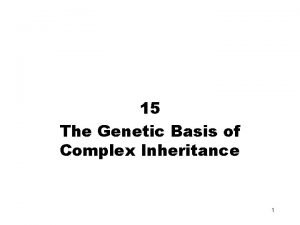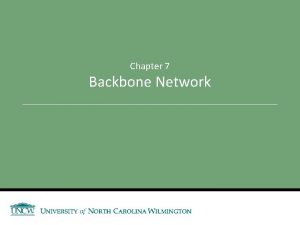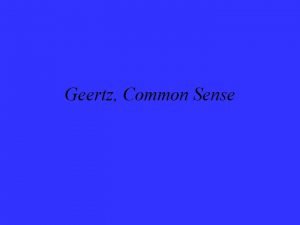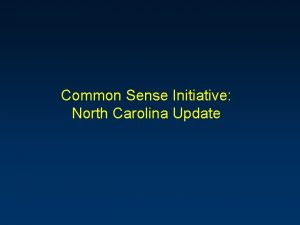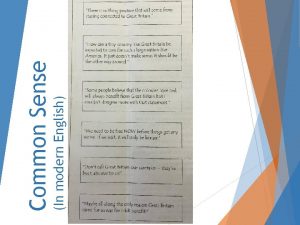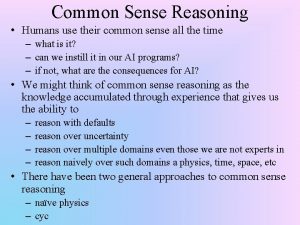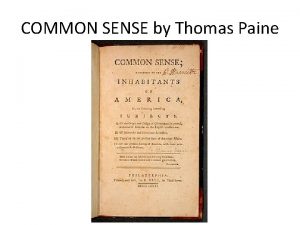The St Thomas Common Sense Symposium Designing Architectures















- Slides: 15

The St. Thomas Common Sense Symposium: Designing Architectures for Human-Level Intelligence Marvin Minsky, Push Singh, Aaron Sloman, AI Magazine 2004 2008. 4. 14 B. -W. Ku /20

A Symposium in St. Thomas (2002) l To discuss a project–to develop new architectural schemes that can bridge between different strategies and representations. l Participants: Larry Birnbaum (Northwestern Univ. ) Ben Kuipers (Univ. of Texas at Austin) Henry Lieberman (MIT) Marvin Minsky (MIT) Srini Narayanan (U. C. Berkeley) Doug Riecken (IBM Watson Research Center) Mary Shepard (Cycorp) Jeffrey Mark Siskind (Purdue Univ. ) Oliver Steele (Laszlo Systems) Vernor Vinge (San Diego State Univ. ) Ken Forbus (Northwestern Univ. ) Douglas Lenat (Cycorp) Henry Minsky (Laszlo Systems) Erik Mueller (IBM Watson Research Center) Ashwin Ram (Georgia Institute of Technology) Roger Schank (Carnegie Mellon Univ. ) Push Singh (MIT) Aaron Sloman (Univ. of Birmingham) Linda Stone (independent consultant) Michael Witbrock (Cycorp) (C) 2008 SNU Biointelligence Lab http: //bi. snu. ac. kr/ 1

The Need for Synthesis in Modern AI l Most researchers in recent years have retreated from the ambitious aim of building a machine that has common sense. l Instead, each developed some special technique that could deal with some class of problem well, but does poorly at almost everything else. l To build a human-level AI, we must develop ways to combine the advantages of multiple methods. (C) 2008 SNU Biointelligence Lab http: //bi. snu. ac. kr/ 2

Organizing the Diversity of AI Methods We need a theory that helps us to map the types of problems onto the types of solutions. l Minsky’s suggestion: The Causal Diversity Matrix (Fig. 1) l Figure 1 (C) 2008 SNU Biointelligence Lab http: //bi. snu. ac. kr/ 3

Returning to the Blocks World A possible target problem domain for a commonsense architecture project l Multiple realms l ¨ Spatial, physical, bodily and visual reasoning ¨ Psychological, social, reflective, conversational and educational reasoning l A model world ¨ Physically realistic ¨ Social problems ¨ Simulated beings participate in scenarios including: < Jointly building structures < Competing to solve puzzles < Teaching each other skills < Verbally reflecting on their own successes and failures ¨ Video game community – programmable virtual world (C) 2008 SNU Biointelligence Lab http: //bi. snu. ac. kr/ Figure 2 4

Large-Scale Architectures for Human-Level Intelligence (1) l How could a meta-theory (as in Fig. 1) of AI techniques be used by an AI architecture? (C) 2008 SNU Biointelligence Lab http: //bi. snu. ac. kr/ 5

Large-Scale Architectures for Human-Level Intelligence (2) l Minsky’s emotion machine architecture (Fig. 4) ¨ Reflective thinking Figure 4 (C) 2008 SNU Biointelligence Lab http: //bi. snu. ac. kr/ 6

Large-Scale Architectures for Human-Level Intelligence (3) Select some “ways-to-think” l Adaptation or switching l Active in parallel l Figure 6 (C) 2008 SNU Biointelligence Lab http: //bi. snu. ac. kr/ 7 Figure 7

Large-Scale Architectures for Human-Level Intelligence (4) l Sloman’s H-Cog. Aff model (Fig. 5) ¨ Cognition and Affect project has explored models for human minds. Figure 5 (C) 2008 SNU Biointelligence Lab http: //bi. snu. ac. kr/ 8

Educating the Architecture (1) l How to supply the architecture with a broad range of commonsense knowledge? l Learning l Start out with too little knowledge would not likely to achieve enough versatility. ¨ Minsky’s complaint about “baby machines” < We don’t know how to do it yet. < Such approaches have all failed to make much progress (C) 2008 SNU Biointelligence Lab http: //bi. snu. ac. kr/ 9

Educating the Architecture (2) General-purpose commonsense knowledge resources l Cyc system l ¨ A great many way to represent commonsense knowledge ¨ Over a million (< adult-level: 100 million) commonsense facts and rules ¨ Move to a distributed knowledge acquisition approach < Volunteer teachers around the world needed < Development of friendly interfaces ¨ Criticism: < Not adequately based on cognitive science < Minsky Ø Need to augment each existing item with procedural and heuristic knowledge, such as descriptions of: target problems; ways of thinking; known arguments for and against using it; ways to adapt it to a new context (C) 2008 SNU Biointelligence Lab http: //bi. snu. ac. kr/ 10

An Important Application l To receive substantial support for such a project. l A personalized teaching machine ¨ It adapt itself to someone’s particular circumstances, difficulties, and needs. ¨ It carry out a conversation with you. ¨ You could discuss with it various subjects. (C) 2008 SNU Biointelligence Lab http: //bi. snu. ac. kr/ 11

Final Consensus l An architecture that can support many different techniques l A model world l A personalized teaching machine (many, but not all, agreed) (C) 2008 SNU Biointelligence Lab http: //bi. snu. ac. kr/ 12

A Collaborative Project It’s feasible when the components can be reasonably disassociated. l Some technical steps l ¨ A virtual model world ¨ Miniscenarios ¨ Protocols ¨ A catalog of ways-to-think ¨ Self-reflections ¨ Commonsense knowledge base ¨ “Intention-based” programming language (C) 2008 SNU Biointelligence Lab http: //bi. snu. ac. kr/ 13

Summary Figure 8 (C) 2008 SNU Biointelligence Lab http: //bi. snu. ac. kr/ 14
 In common sense, thomas paine argued that
In common sense, thomas paine argued that Narrow sense heritability vs broad sense heritability
Narrow sense heritability vs broad sense heritability Narrow sense heritability vs broad sense heritability
Narrow sense heritability vs broad sense heritability Product vs process layout
Product vs process layout Aaron bannert
Aaron bannert Backbone network design
Backbone network design Backbone network architectures
Backbone network architectures Gui architectures
Gui architectures Fundamental and incidental interactions
Fundamental and incidental interactions Isa instruction
Isa instruction Autoencoders
Autoencoders Cache coherence for gpu architectures
Cache coherence for gpu architectures Database system architectures
Database system architectures Database and storage architectures
Database and storage architectures What is ecommerce architecture
What is ecommerce architecture Theo schlossnagle
Theo schlossnagle


